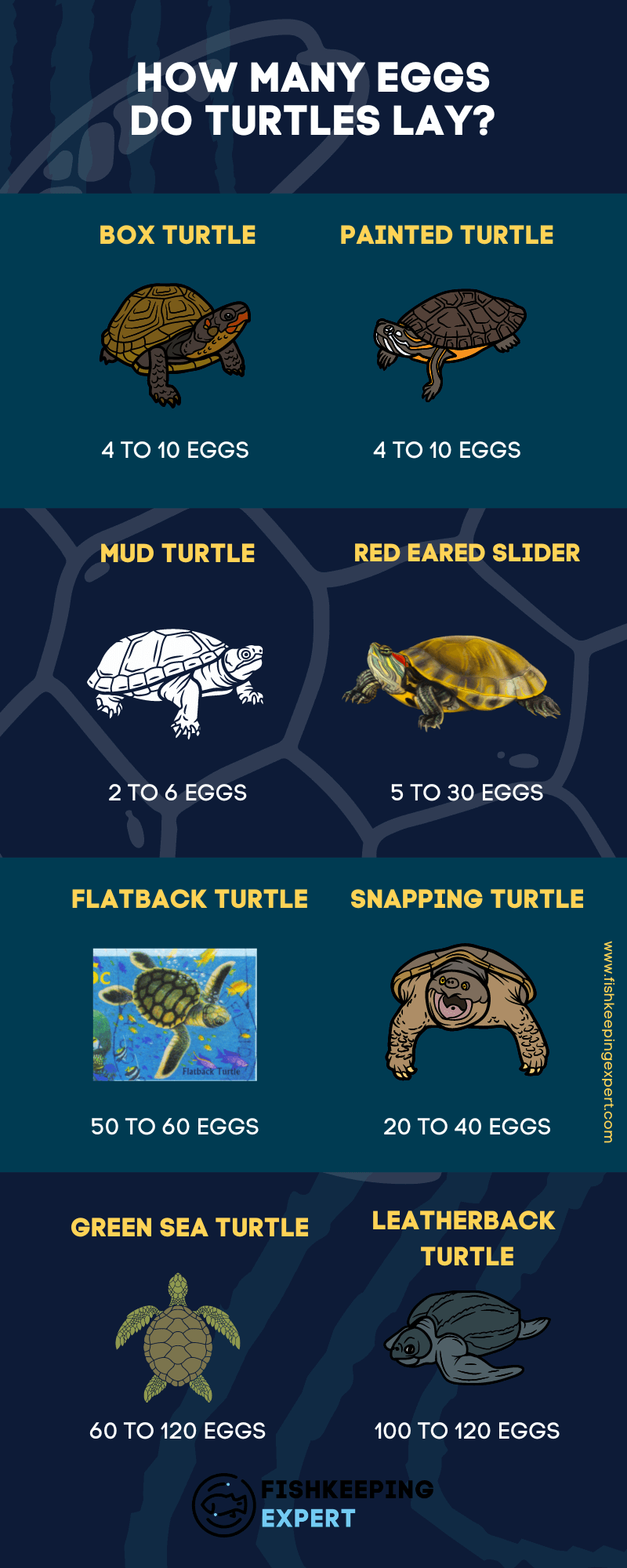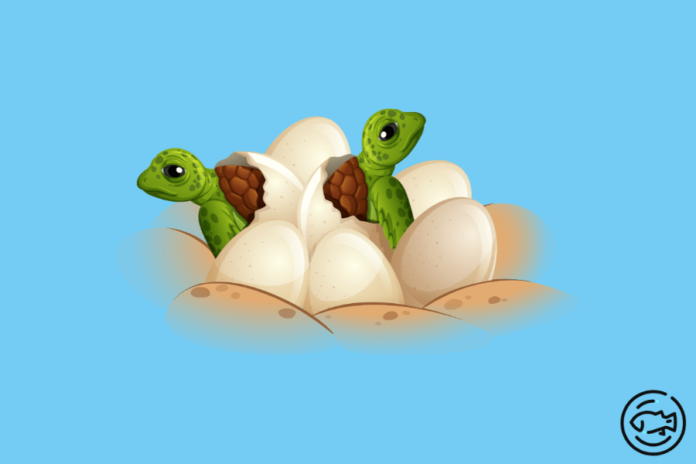Female turtles should lay eggs at maturity if you provide them with a suitable habitat and nesting spot. Seeing your turtle eggs is one of the most exhilarating occasions you can have as a new turtle owner, and you must incubate the eggs for a few days until they hatch. Now, How Long Does It Take For Turtle Eggs To Hatch?
The answer is that turtle egg hatching usually takes between 45 to 90 days. But, the incubation time of different species of turtles can differ according to whether they live in freshwater or seawater.
The information we share today will answer all of your questions about when turtle eggs hatch within various species.
When Does Turtles Lay Eggs?

In the year’s warmest months, you can expect sexually mature turtles to lay eggs. There is a wide range of times between May and July when turtles lay their eggs, depending on the species, as turtle eggs are most easily incubated during these months due to the ideal temperature.
There is no difference between saltwater and freshwater turtles when it comes to egg-laying, as both lay eggs on land.
During nesting season, the female turtles search for an appropriate spot on the shire to lay eggs, and it is necessary to incubate the eggs in moist sand or soil.
Many turtle species dig fake nests as a means of confusing predators. Turtles can lay eggs within an hour to approximately three hours.
As soon as the eggs are laid, they cover them and leave the nesting site.
How Many Eggs Do Turtles Lay?
In a clutch, turtles can lay anywhere from 3 to 100 eggs! The number of eggs a turtle produces depends on many factors, including the type of species, the different age groups, and the different sizes. During the nesting season between May and July, the turtles lay their eggs in multiple clutches over a period of 15 to 30 days.
Sea turtles, for example, in the course of a season, can lay between 2 to 10 clutches containing 25 to 100 eggs. Thus, it is a possibility that they may lay 100-150 eggs per season.
But, the species of box turtles are an exception as they only produce a clutch of eight to nine eggs only once per year.
In addition to species and size, egg production varies based on the species of turtles. Therefore, here we have mentioned the number of eggs produced per clutch by some popular turtle species:

There are approximately 100 eggs laid in each clutch of large sea turtles. They can hold many eggs because of their large plastron size. In contrast, turtles of small sizes, like box turtles and mud turtles, do not have a lot of space in their plastron. Because of this, only 2 to 10 eggs are laid per clutch.
How Long Does It Take For Turtle Eggs To Hatch?

Each turtle species has a different incubation period. Additionally, it cannot be forecasted when the turtle eggs will hatch, but it is safe to assume that it will take almost 2 to 3 months for them to hatch.
Now, you must be wondering about the reasons for varying hatching times for turtle eggs. When do they hatch, and why does it take so long?
There is a difference between the living environment of a sea turtle and a freshwater turtle. This way, the hatching time is affected by temperature, humidity, and nest depth. In order for turtle eggs to hatch, the temperature needs to be between 80 and 90 degrees Fahrenheit, and having a warmer climate will speed up the hatching process.
The nest size should also be considered, as the turtle eggs take longer to hatch when more eggs are in a nest.
One clutch of some turtle species consists of about 100 eggs, which can take about 75 to 100 days to hatch, while the other turtle species can have only 5-10 eggs in one clutch, which can hatch in 50-90 days.
What To Do When Turtles Lay Eggs?

There are two options available to you when you find your turtle’s nest, which are that you incubate them so that they can hatch properly or you can get rid of them.
You may want to hatch the eggs to add more turtles to your family. Then, it is up to you to either keep the hatchlings or give them away to turtle shelters once they hatch.
Natural Hatching
It is important to prepare a nesting area for your turtle as soon as you know that your turtle is going to lay eggs. Therefore, you can build a nest box in your yard or garden area. But, be aware, as you should always ensure that the turtles are safe when doing anything.
Turtles must have found an appropriate nesting spot to hatch their eggs if they have laid eggs, as whenever turtles nest, they search for the best place to do so.
In order to build their nests, they dig an opening in the wet sand or soil. After that, they lay the eggs and leave them for the incubation period.
As a result, you can instill confidence in your turtle’s decision undoubtedly and allow the eggs to hatch naturally in its nest. However, there are some risks involved with allowing your pet to hatch the eggs outside that you must be mindful of, like the varying weather, & unstable temperature levels.
There is also a risk of intruders or predators damaging the nesting spot. As a result, you must ensure that turtle eggs hatch naturally outside by equipping them with essential protections.
Artificial Hatching
Incubating turtle eggs artificially is one of the adequate methods to ensure most of them hatch. And by doing so, you will also be able to influence or manipulate the gender of the newborn turtles. Incubators can be bought or homemade, and you do not have to pay much cash for them.
Moving the eggs carefully when transferring them to an incubator is very important. It is possible that when you found the egg, the embryo had already formed; therefore, it is not possible to adjust the orientation of the eggs after transferring them to the incubator.
When you incubate eggs for hatching, you get to choose the temperature at which you want to hatch the eggs.
Male turtles are produced when eggs are incubated below 80°F, whereas if the temperature is above 85°F, you can expect many females. And, if you fluctuate the warmness between these temperatures, you will get a blend of both males & females.
also read: Florida Softshell Turtle – Do Softshell Turtles Bite?
Do Turtles Sit On Their Eggs?
Despite the fact that turtles lay eggs, they will not sit around protecting them. A turtle that buries its eggs in the sand immediately leaves the location. It doesn’t mean that the eggs do not matter to them.
They choose nesting sites based on the best conditions, and you can trust their judgement. They also dig their nests in well-hidden places in the wild, where they dig a deep enough hole which provide the right temperature for their eggs to hatch properly.
Why The Turtle Eggs Do Not Hatch?
Despite incubating the eggs for 50 to 90 days, you may not receive as many turtles as you had hoped, and many factors can cause infertile turtle eggs.
- One of the most interesting turtle facts that you need to know is that a sexually female turtle is capable of laying eggs without having to mate with a male turtle. However, these eggs do not have the potential to become fertile, and naturally, you would not be able to expect to have turtle babies from these eggs.
- If the temperature of the eggs is dropped below 80 degrees Fahrenheit or increased over 95 degrees Fahrenheit, the eggs will become infertile.
- During the process of transferring eggs to the incubator, it is very important not to misorient the eggs in any way because it may result in the death of the embryos within the eggs.
How To Know If Turtle Eggs Are Infertile?
If you have discovered eggs in a nest, you may be unable to tell whether they are fertile or infertile. There is a simple test that you can perform to find out if that is the case.
- It is important to take the turtle eggs out of their nests without changing their orientation and to place them in a vessel filled with wet sand or vermiculite to keep them warm.
- Next, you need to take them into a room that is completely dark, and one by one, choose each egg. To examine the inside of these eggs, hold them up to an LED flashlight and illuminate them so you can see what is inside.
- A red circle will appear inside of an egg if it is fertile, as well as visible veins, which is a sign that the egg is fertile.
- A fertile egg’s color and texture also change during the fertilization process.
- During the egg development process, some turtle species lay a pinkish-white egg with a soft outer shell. As time passes, the color darkens. Eggshells also become harder over time as opposed to soft eggshells in the early stages.
The date of the laying of the eggs may not be known to you. Therefore, wait a week before disposing of them, as it might be possible if your eggs show some signs of embryo development within a week. If that does not happen, you can dispose of all the infertile eggs.
How Long Do Box Turtle Eggs Take To Hatch?
It is not uncommon for box turtles to start procreating almost immediately after they have emerged from hibernation. And approximately one week after the pair has mated, the woman becomes pregnant. May-July is the best time for your female box turtle to lay eggs if she has reached sexual maturity. Box turtles reach sexual maturity between the ages of five and ten.
It is estimated that one or two clutches of about 2 to 6 eggs, or even as many as 10 eggs, are laid per season. Several elements are instrumental to the speed of the hatching process, including the nest size and the temperature of the nest. Therefore, baby box turtles are expected to hatch between August and October.
How Long Does It Take For Snapping Turtle Eggs To Hatch?
As nocturnal animals, snapping turtles prefer to spend most of their time underwater, where they can stay cool and protected. Snapping turtles, though, make their nests in the sand near their habitat so they can lay their eggs when it is time to lay them.
Compared to many other species, these birds lay about 25-40 eggs in one clutch, so there is quite a bit of disparity in the eggs laid in a single clutch. Therefore, it is expected that the eggs’ hatching will take about 100 days.
In early April, snapping turtles will start to lay eggs, indicating they are ready to lay them. Throughout the months of July, August, and early October, depending on the temperature, other incubation conditions, and other factors, you may be able to see the eggs hatch.
How Long Does It Take For Sea Turtle Eggs To Hatch?
Sea turtles can be found in a wide variety of species. Eggs can be laid by some species throughout the year. Sea turtle egg hatching typically takes place between June and early October.
As we mentioned earlier, some of them are capable of producing up to 120 eggs at the same time. The incubation period is, therefore, subject to change due to various factors.
As a result of the temperature and humidity of the nesting area, sea turtle eggs can sometimes take 45 to 75 days to hatch and sometimes even 90 days to hatch. Incubation of sea turtle eggs is best carried out at temperatures between 80 and 85 degrees Fahrenheit.
Conclusion
As you know by now, different species of turtles hatch out at different rates over a period of 45 to 90 days. Baby turtles emerge from their nests, most commonly in late summer or early fall.
It is essential to keep an eye out for turtle nests during the turtle nesting period if you have a pregnant turtle. You can grow your turtle family by hatching baby turtles, keeping them in a properly-cared-for environment, and using proper incubation techniques.


